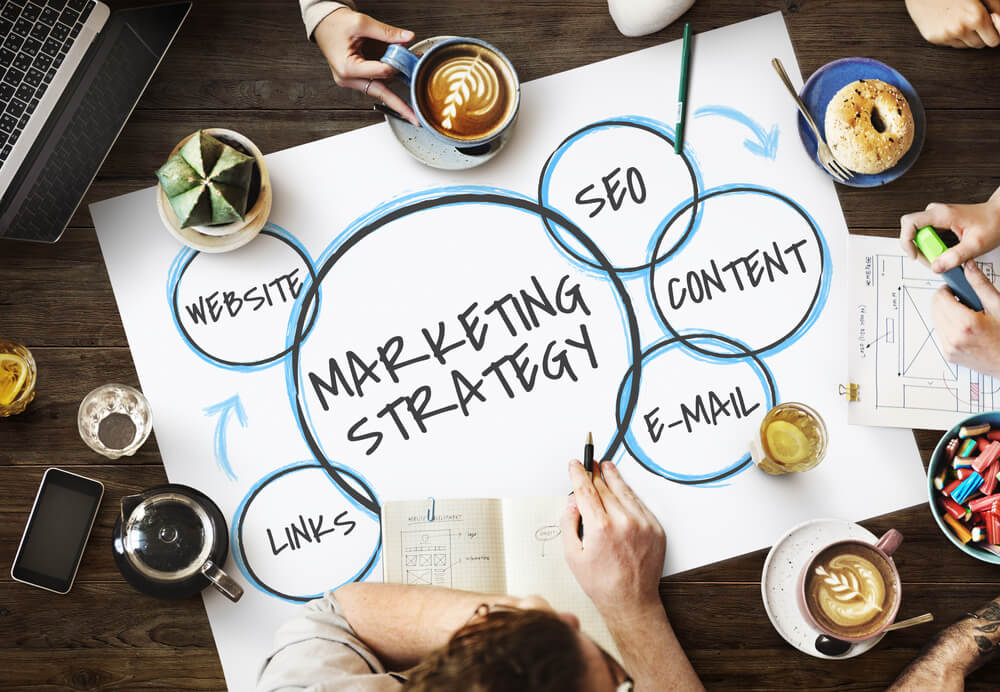
Build a one-page digital marketing strategy that’s clear and effective. Includes a free template to help you get started quickly.
One-page digital marketing strategy helps you organize your thoughts, define a clear target, and establish measurable ways to track your progress. Here’s a look at what you can experience when you spend the time to outline your marketing strategy.
First, let’s review what details and information will go in your one-page marketing plan. While it’s simplified compareFirst, let’s review what details and information will go in your one-page marketing plan. While it’s simplified compared to a full marketing plan, it will still require that you sit with your strategy and spend time getting to know market factors.
Key areas of your marketing plan can be broken into three key phases with three crucial strategic areas underneath:
Attracting the prospect
Nurturing the lead
Delighting the customer
The most thorough method for getting to know your audience is to create buyer personas for each audience segment. But in lieu of that, you can simplify it with an audience overview.
Write one statement about each of the following.
1. Who Your Audience Is
This can be a short description that states male, female, or both, age range, profession or income level, interests, communication preferences, and goals.
Example: Our customers are prominently female – though males are not excluded – who work within the marketing department of small to medium businesses, looking to grow their business through modern digital marketing strategies with a goal of increasing sales 5% in the coming calendar year.
2. Outline Their Pain Points
Getting to know what frustrates or pains the audience can help you speak to their needs more completely. You’ll know where they’ve turned for help and where they’ve come up empty in the past. Or what is holding them back from achieving their goals?
Example: The marketing professional has used a marketing agency in the past with minimal success or has struggled with unresponsive freelancers. But their budget is insufficient to hire a full-time marketing strategist, so augmenting their team with an agency is the best option.
3. State How You Can Help
Now is your chance to evaluate the best way your business can be the hero in this customer’s story. Take some time to evaluate how you can fill the gaps for this customer and be what they are looking for.
Example: New Light Digital offers an experienced team that knows how to work with marketing professionals to meet their goals within a set budget.

The messaging section of a marketing plan is twofold. It explains both what you’ll say and how you’ll say it.
For example, you should spend time outlining your key features and benefits and then compare them to your competitors’ marketing. This will tell you whether your competitors are targeting the same areas of the market and how you can differentiate yourself by highlighting what makes you unique.
It doesn’t mean you have to have a completely different product or even a different audience from your competitors, but just that you decide an aspect of your product or service is the most important aspect of your business, and therefore, what you’ll lead with in your marketing.
The second part of your messaging plan details your voice and tone. Some brands use humor; others would never jeopardize their customer relationship with the risk that the humor might not land right. Your brand might be playful, serious, caring, inquisitive, etc. But you shouldn’t change that tone abruptly from one marketing message to another. That’s the value of outlining your messaging and tone. You’ll ensure a consistent relationship with your customers and make it so that, even without seeing your brand name or logo, the customer could look and know the marketing was from you.
When outlining your messaging plan on a one-page marketing plan, you’ll need to keep it simple since you don’t have tons of space. So consider expressing your voice and tone as simple words. And draw out your key consumer benefit as your main message to your customers.
Once you know who your customers are and the key messages you’ll use to attract them to your brand, you need to evaluate where they are and how you can reach them. You can’t just build a great website and expect that your target audience will find you.
Fitting your full media and tactic plan in the small section of your one-page plan will be challenging as there are so many excellent ways to build awareness and nurture a relationship with your target audience.
Some of the media and marketing tactics available to your company include the following, though you should know that not all businesses align with all tactics or find the ROI worth it. You should evaluate these tactics carefully as you decide how to build your efficient and effective lead-generation engine.
After completing your audience overview, messaging plan and tactics, you’re ready to move into considering how you’ll turn a prospect into a lead. This is an essential element of any marketing plan because it’s where you’ll detail the nitty gritty details of how you’ll turn unknown visitors into known prospects who you can nurture toward a sale.
The first step in building your lead engine is to evaluate how you’ll collect the lead. This includes the technology on your website, marketing automation software, and personnel who will handle sales calls or online processes for doing so.
Spend some time exploring your website as if you were landing there for the first time. Consider how easy it is to reach your business or learn more. Are there prompts inviting you to download an ebook, reach out to customer service, or share your email address to get newsletters? Or is the online experience one-sided, where you simply tell the customer how great you are?
If it’s the latter, you need to outline how you’ll change this experience to one that invites interaction with website visitors, prospects and customers alike.
But don’t just think about your website. Consider what happens when someone visits your booth at an event or reaches out to you via social media. How can you adapt that sales funnel to other media and tactics that don’t filter through your website?
This is crucial because how you capture the lead will impact how easy and seamless it is to go to the next step of nurturing your leads.
If you don’t have a CRM or other database solution that is accessible to your full team, it’s time to evaluate such systems to avoid prospects and customers from being housed within each salesperson’s email accounts or trapped on a shared email that displays form fills but has no clarity around the last touchpoint with that prospect or customer.
Your goal here is to capture both the lead and the interactions between your business and your customers.

Before you begin capturing leads, you should think through your lead nurture system. This ensures that propsects don’t start reaching out to you and then hear little or nothing from you until the lead goes cold.
A lead nurture system includes both automated and manual outreach to prospects and customers. It should start with an email, text message or other outreach shortly after the prospect shows interest, either by completing a form, visiting the site as a known visitor, or completing their first purchase if you own a transactional e-commerce website.
The first touchpoint should offer an overview of your company, and if relevant, details about the product or service they showed interest in.
But that shouldn’t be the last that the prospect hears from you, even if they don’t interact with your business again. You should build in additional touchpoints to connect and build a relationship with the customer. This can include offering exclusive content, further details, invitations to take the next step – such as scheduling a demo or sales conversation – details on how to purchase, or cross-selling other products the customer might find valuable to enhance their experience.
Once you’ve nurtured the customer, you must close the deal. You need a sales conversion strategy to turn prospects into customers.
Each part of your lead nurture strategy should have an appropriate call to action, starting with “learn more” and leading to “buy now” as they learn more and show more interest in your company.
Your sales conversion strategy might include how to get them to talk to a salesperson to discuss options, pricing, etc. But in the case of an e-commerce business, it might be as simple as how to close an online sale. Perhaps it’s an exclusive offer that the customer can’t resist. Maybe it’s timely to remind them to reorder based on when they placed their first order.
It starts with understanding what brought your customer to your company. That’s why your audience overview is so important. It should include the challenges your customers face, their objections to your products or service, and their goals when shopping for a product or service like yours. That will help inform you of your method for closing the sale.
Your work isn’t done when you close the sale. Now you need to write your plan for how you’ll deliver world-class service to develop lifelong customers with high lifetime value. A satisfied customer will keep returning and will tell their friends and family about you so that your audience grows naturally.
Your plan should include ongoing interactions with the customer after they’ve purchased. This might involve sending help guides, troubleshooting, complimentary products, how to get in touch with customer service or sales, other use cases for your products or services, etc.
When considering your world-class service, don’t just think about the time that immediately follows the sale. Consider your lifelong relationship with the customer and what they might need.
This should also include your warranty and return policy. Look for ways to maximize your free shipping and returns to meet market demands for these services. That might mean pricing your products a little higher to cover the cost of such policies, but it’s often worth it in the long run.
The customer lifetime value is how often your customers come back for additional purchases, or increase their buying from you. Ideally, you won’t be seeing tons of customers who buy from you once and never come back.
Part of this might include developing a plan for how you’ll roll out new products that complement your existing offering to encourage repeat customers, especially when you sell a one-time product or service or one that will last the customer for years.
One aspect of increasing the customer lifetime value is to stay in touch with the customer. So don’t let your nurturing system end with a sale. Communicate with past customers regularly to stay top-of-mind for all their needs that your company can fulfill.
One of the most affordable and effective ways to bring in new customers is to build a referral program. Prospects who come through a referral are already primed and ready to make a purchase in many instances. That’s because they’ve heard first-hand what’s great about your company.
The nudge that referrals get from their friends, family or acquaintances can be very effective in selling your products. And while this can happen organically without you having to do anything, building a referral program will encourage such referrals and build your prospect list effectively.
A referral program can be as simple as reminding customers at regular intervals to share their experience with their contacts. Or it can be as involved as providing customers with a special link or code that they share with their contacts for incentives.
Some companies run frequent referral competitions or raffles where customers can win a gift card if they refer someone within a specified period. Others have an ongoing program that offers such referrals.
Depending on the business you’re in, recognizing a referral might be enough. Many realtors send thank you cards or small trinkets of appreciation when they get a referral to show gratitude while also encouraging future referrals. This is wise in a business with minimal repeat customers since people don’t buy multiple new homes in short periods, most of the time.
Consider your target audience and what might incentivize them to refer customers to your business and develop a clear plan that you communicate to your customers.
Now that you know what should go into each aspect of your marketing plan, you’re ready to download your free template and get started.
If you struggle to complete the exercise, you’re not alone. Even when simplified into one page, writing a marketing plan is complex and requires deep knowledge of marketing and business strategy.
It might be time to partner with a strategic digital marketing partner. If you’ve worked with a marketing agency in the past and had mixed success or no success at all, know that all agency relationships are not the same.
New Light Digital is responsive, strategic, and prepared to help you improve your company’s ROI through a thoughtful and strategic marketing plan. From there, we can help you enact that plan with specialists in websites, email marketing, SEO, content, and social media.
Schedule your free consultation now to learn how we’ve helped businesses just like yours accomplish their goals and realize their potential.
Further reading: